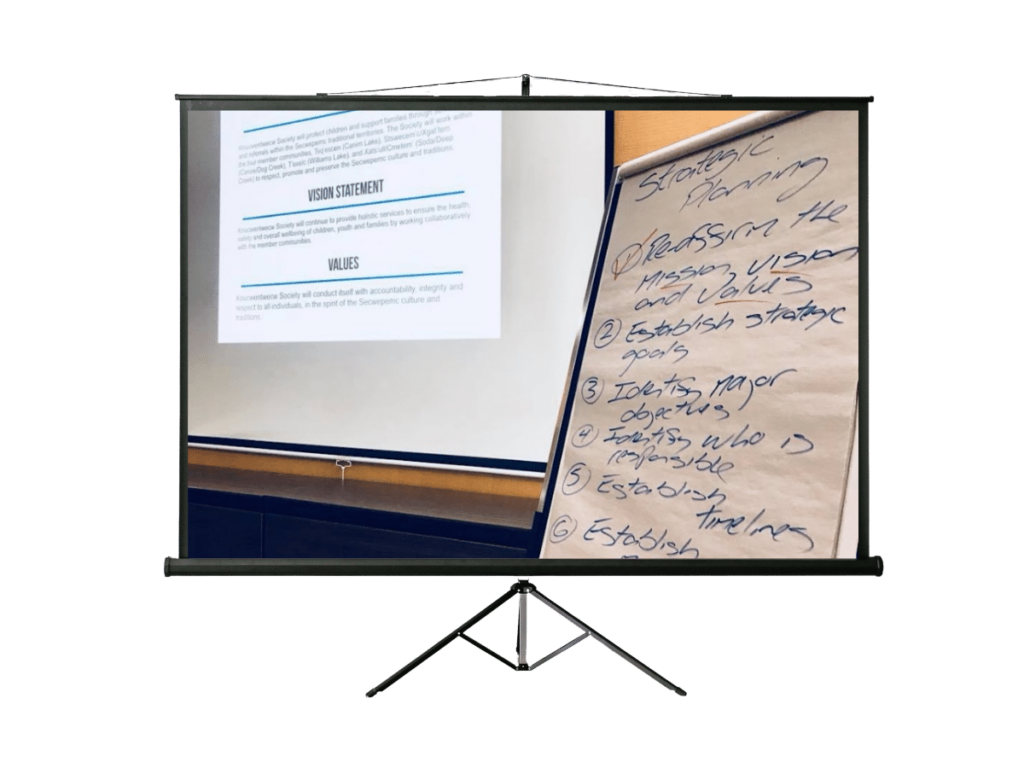In this episode of the Strategic Nonprofit Podcast, join host Trista as she meets with the CEO of AMC NPO Solutions, Tom Abbott, to discuss how nonprofit organizations can begin developing and monitoring their strategic plan.
Also read:
- Choosing A Nonprofit Strategic Planning Facilitator: A Step-By-Step Guide
- Nonprofit Strategic Planning: The Planning Process
- Failing to Plan: 8 Reasons Why NPO Strategic Planning Fails
Whose responsible for creating the strategic plan?
In the Complementary Model of Board Governance, the Board is responsible for developing, creating, thinking about and articulating the strategic plan.
Whereas some models like the Carver Model put the responsibility of developing the strategic plan with the Chief Staff Officer, the CEO, or the Executive Director. A huge mistake, in Tom’s opinion, for a few reasons:
Legal liability: The board of directors are legally responsible for the organization’s management and governance. This means they are responsible for the direction that the organization goes. Thus, they need to develop a strategic plan in the absence of that.
Boards provide insights: The board and organization should be working in coordination. While the ultimate decision as to what those strategic goals and objectives are lies with the board, senior management has boots on the ground, knows what’s going on and can provide plenty of helpful information.
Let’s explore the responsibilities and roles of those responsible for creating the strategic plan in further detail below:
Board Members
If at least 90% of the directors can’t attend the strategic planning session, then you must postpone the session. That’s because the strategic planning session is one of the most important activities your board will undertake during its term. If attendance is low, so will the value of the outcome.
Senior Staff
Senior staff should also participate fully in the discussions and debates.
After all, the senior staff will develop the subsequent operational plans and budgets and then work on implementing the strategic plan daily. In addition, their participation and input will add an essential operational perspective to discussions.
However, the participation of senior staff should not eclipse the board’s decisions. For instance, staff should not “vote” on any aspect of the strategic plan.
Respected Advisors
Many nonprofit organizations engage the services of an experienced external facilitator to coordinate the process and mediate the strategic planning session. Overall, this method has the following benefits:
- As the facilitator takes on the coordinating role, this releases all participants (including the board chair and the CEO) to partake in the discussions actively.
- The facilitator can bring an independent viewpoint to the discussions.
- The facilitator can bring to the group experiences and solutions that have been successful in other organizations.
Whose responsible for implementing the strategic plan?
While the strategic plan is “owned” by the volunteer board, it is the staff’s responsibility to implement the plan to the best of their ability, regardless of their view.
Overview of the Nonprofit Strategic Planning Process
1. Articulate why the organization exists
The first key element in the planning process should be articulating why your organization exists with a clear, concise, and inspiring statement that declares what it is about, what it does, for whom and where.
Generally, the Mission Statement should be short enough to be reproduced on your website and letterhead, framed and displayed throughout your organization, or even printed on a T-shirt.
Overall, your organization’s Mission Statement should be the gauge against which your organization measures the success of every activity.
2. Establish goals & objectives
Typically, four or five goals will be the most that any organization can realistically hope to focus on and work to accomplish over the next few years.
When you have decided upon your four or five goals, you must turn your attention to establishing specific objectives that support each of the goals.
While this is a standard procedure at most strategic planning sessions, in some organizations, the task of developing specific objectives will be delegated to staff or committee(s).
3. Develop time-phased plans & identify measures of success
Now determine timelines for completion of the work, alongside a time frame for progress reports to the board.
While it may not be possible to determine when each goal and objective can be accomplished in every case, at minimum, the board should decide when it would receive progress reports on the status of the work. For instance, the directors may determine that progress reports be submitted at every board meeting.
More so, during the planning session, the board must decide how to measure success. For this reason, it is essential to establish a quantifiable measure of success.
4. Identify who will be responsible for meeting goals & objectives
Don’t let your planning session end without assigning whose responsibility it is for accomplishing each goal and objective; either to an individual or a committee.
Doing so will establish an accountability framework that will increase the probability of successfully achieving your goals and objectives.
5. Establish a monitoring system
With so much activity in your organization, your board will struggle to keep up with everything. As such, the last element of the strategic planning process is establishing a monitoring mechanism to assess how well the organization is progressing in meeting its objectives, goals, and mission.
Create a brighter future for your organization with AMC
AMC’s skilled strategic planning facilitators can help you navigate complex issues and build the transformative plan you need for success.
Whether you have a specific goal, troublesome problem or a new exciting opportunity you need assistance navigating -AMC’s customized strategic planning sessions will help.
Contact us today to learn how AMC’s Strategic Planning facilitators can help your organization develop, improve, and grow.

